It is rare for someone or something to be a constant presence in your life. Going over the photos of my Polar V800 from the past year for this review made me realize how prevalent it has been for me and all that I have experienced with it on. Unlike a normal watch, this device was the catalyst for many of the adventures I had embarked on, thus making it truly something special. However, now due to my demands of such a device having grown to greater heights and depths, I must pass it along to a dear friend, and now seems the best time to give you an in-depth review of this truly spectacular watch.
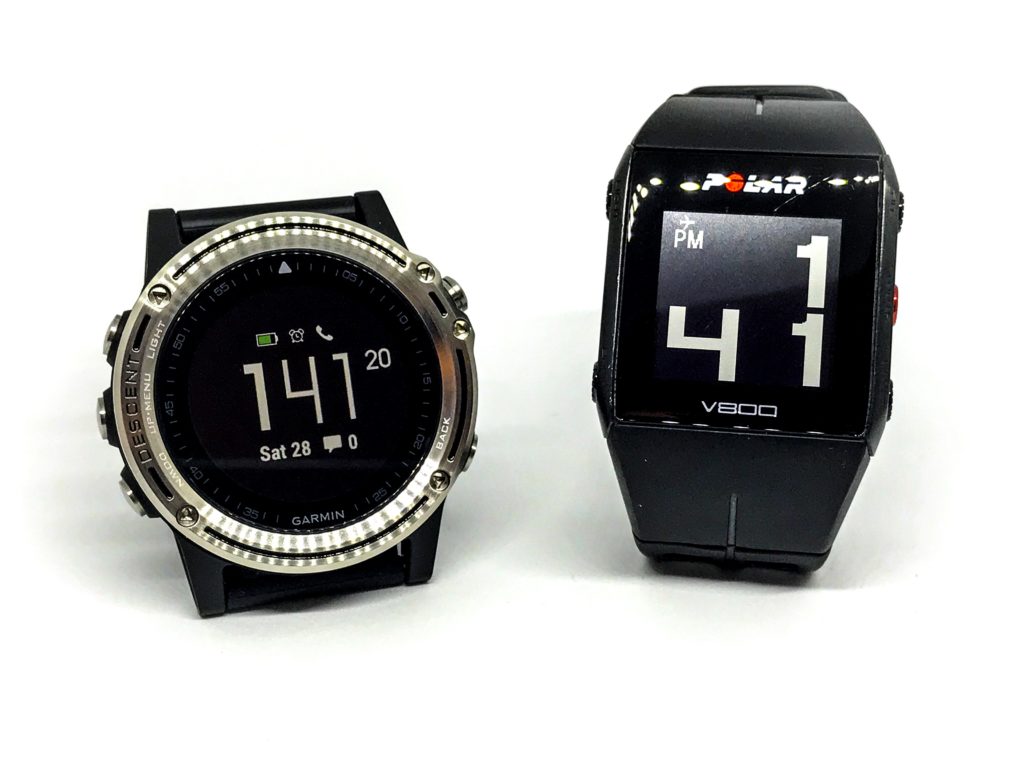
My V800 alongside its successor – The Garmin Descent Mark 1
First off I will tell you why I jumped into the world of wearables and how I landed on the Polar V800 that is a professional grade device. I wanted to get more out of my exercises and start tracking my results and bought a Polar Loop and an H7 Heart Rate monitor. I quickly surpassed the Loop and got the more versatile V800 in about a month. The ability to choose sport profiles, customize heart rate zones, and have GPS functionality were huge benefits that I simply needed in order to better attain my goals.
Polar Flow Software & Activity Tracking:
The one feature that the Polar Loop (and later the V800) had introduced which I found invaluable was the Activity Tracking and the progress bar for my activity level throughout the day. On days that I was either suffering from an injury, a cold, or simply too tired to get in a workout, I found ways in filling up the bar and simply being active. Coupled with the sleep tracking and its basic metrics, I used this data to more intelligently exert myself on that particular day. The V800’s amazing battery life of around 10 days of normal use allowed for the watch to be worn in bed, unlike some other fitness focused smartwatches on the market. Also unlike other makes such as Garmin, the users progress in not simply relying on steps or flights of stairs taken. Polar uses a special algorithm in unison with its accelerometer that also measure the amount of effort you are expending. The user could try and cheat the system by sitting on their coach and violently swinging their arms in an attempt to simulate active behaviour. Though they will get some fake results, they still had to exert some effort in doing so, and trust me, others have admitted to doing this and oddly seemed proud of it. Using the Activity Bar as it was intended ensured results over the long term, but I have seen it do the exact opposite for others.

Filling up the Activity Bar resulted in guilt free treats which made ice cream a lot more enjoyable.
I have heard and seen many examples first hand where people got depressed by such activity bars and ended up not using the devices. Seeing this happen in real time made me immensely sad for I could relate to how they felt, but felt helpless in trying to change their attitude and outlook towards reaching their fitness goals. The same phenomenon has been seen on Active Social Sites such as Strava where users get discouraged by the performance of others and simply quit. This very real reason is one of the reasons why I do not share the details of my workout achievements because over time it can have a very negative impact on certain individuals. I will touch on this point at the end of this review and as to whether or not I would recommend this or any product like it.
This Activity Tracking feature made it personally easier for me to become a healthier person, but with the web based and mobile based software which Polar calls “Flow”, this became all too easy.

An example of Polar Flow. and how it translates to your device.
Like Garmin, Suunto, and others in the wearable fitness field, Polar’s Flow service proved to be an ideal and reliable companion throughout the entire year. When compared to the system by Garmin, the V800 and the Flow web service do fall a little short in some areas, yet are ahead in a couple. First, the sleep tracking on my Garmin device was more helpful and more accurate. There were numerous times that my Polar device and app thought I sat still for six straight hours instead of actually being asleep. Garmin’s “Deep” vs “Light” sleep is also more helpful in understanding your sleep the following morning, and thus planning your day accordingly. My Garmin also syncs a lot faster than my Polar. This is true both through USB and via Bluetooth (WiFi on the Garmin as well). Thankfully Polar does not include any of the Gamification aspects towards reaching fitness and training goals. It is understandable as to why Garmin has included this in their application, but relying and becoming dependant on an external source of reinforcement for your fitness objectives is not an ideal way to go about taking care of oneself in the long term. Lastly, The Flow App does a better job of graphically summarizing your day in one circle diagram whereas on the Garmin Connect IQ application and web service, the user will have to scroll down a page in order to see their activities. This can be a little annoying if you have done more than a few hours of exercising across multiple types of sports and activities.
The V800 synced with the mobile application with ease and to the desktop web based software through it’s proprietary charging cable. There are many claims on the internet that this cable is not reliable, but if you carefully attach it to the device and do not rush it, it will work 100% of the time. There was only one two day period in which Flow web service was down. I did not have an issue with this for the V800 stores your workouts and I simply filled in my workout notes when the service became operational again. This is where the Flow service proved to be an amazing tool and allowed me to become my own personal trainer by taking detailed notes and tracking my progress over time. For those who are serious about using such devices to better their health over the long term, such services should be used to their full potential. Not only were the heart rate results, distance, speed and GPS data stored, but they are displayed in a linear fashion that allows you to come to direct conclusions about your efforts and overall fitness progress.
The Training Status feature felt more like a gimmick since my body was the best feedback as to whether or not I was ready and healed up enough for my next training session.
The Device Hardware & Software:
The reliance on Flow however does highlight one of the many short comings of the Polar V800 device itself. In a time where wrist based GPS mapping are now common amongst professional grade devices such as the offerings from Garmin and Suunto, the V800’s reliance on having to sync the device with the Flow application to get a better view of your run did become annoying. With other devices being able to create courses, set you on a path towards nearby landmarks and to guide you through the terrain was sorely missed. These features are so handy and a pleasure to use that I could not see myself going back to the Polar only after a couple days of use. Compared to other devices such as my Garmin, the GPS also took a painfully long time to sync minutes versus seconds. This syncing process was made far worse if there were any trees or medium sized buildings around.
Though the device is very legible and simple, there are a few features that it requires at this price point and that are very useful on its competitors devices. Having an (A) Altimeter (B) Barometer and (C) Compass is always useful on such a device during workouts or even walks. I have used the compass on many occasions in a new city or coming out of an underground subway exit. Garmin’s Barometer and storm warning alert system is also not only a cool thing to have, but helpful on hikes. Other than the ABC functionality, the extra widgets and pieces of software such as sunrise/sunset times, and tide charts are missing on the V800 due to its relatively simple operating system.

Being super legible while training was an asset.
Overall this is a design decision which I understand for I actually really like the simple and dated display of the device. It allowed for easy operation, quick OS responses to every input, and a stability that could only be outdone by a Casio G-Shock. The device crashed only once and it was not during a workout. It also results in a very clean and understated look which I grew to appreciate. In times where devices are using advanced and brilliant OLED screens, my Garmin Descent in comparison can look underwhelming, whereas the Polar looks steady and refined within its limits at all times. As stated before, the battery life of nearly two weeks was definitely made possible by using such a dated looking and less taxing screen.
The device itself otherwise held up quite well over its year of use. With only a small chunk of the PVD coated bezel being taken off, and a sizeable long and thin scratch on the Gorilla Glass, this watch has performed admirably hardware wise. In case you are interested, the scratch occurred during a run along a metal railing as I was turning a corner.
The strap has many, and I do mean many, holes so you can find the absolute perfect fit for your wrist as it expands throughout the day. This strap also exhibited nearly no wear at all during its time on my wrist. The amazing strap could not override a design flaw to ensure ultimate comfort though. The attractive (to my eyes at least) rectangular case is where I found to have the biggest issue with regards to comfort. The constant and large contact patch of that long case did eventually cause irritation over time forcing me to not wear the watch to bed, thus getting rid of my ability to get any of the sleep metrics. The irritation got so bad that I had to apply moisturizer to the effected area in order to keep wearing the watch. This is the first time that I have ever experienced this, and I have worn some pretty large and heavy time pieces in the past. Any discomfort from the rectangular case thankfully disappears when one is in the middle of a workout and is primarily present when one is sitting down. Some Garmin devices such as the Forerunner 935, Fenix 5 Series, and my Descent allow you to flip the straps around with their QuickFit strap system. This means that if you choose to wear the device on your right wrist, the buckle is no longer strangling your tendons, and is positioned along the side of your wrist.
Device Battery Life & External Heart Rate Monitors:
The V800’s battery life was and remained amazing throughout the entire year and did not degrade as some other devices naturally do. When not using the GPS features, yet still training everyday for a minimum of 90 mins, the watch easily lasted into 10 days with out a problem. Like other devices though, using the GPS feature will severely impact the battery life. Polar has an option for you to set the intensity of the GPS monitoring so you can prolong the battery life in case you are tracking very long run or activity. The accuracy of the tracking will take a hit, but this was a trade off that I did not mind for it primarily miscalculated transitions in directions only to retain the general heading taken.
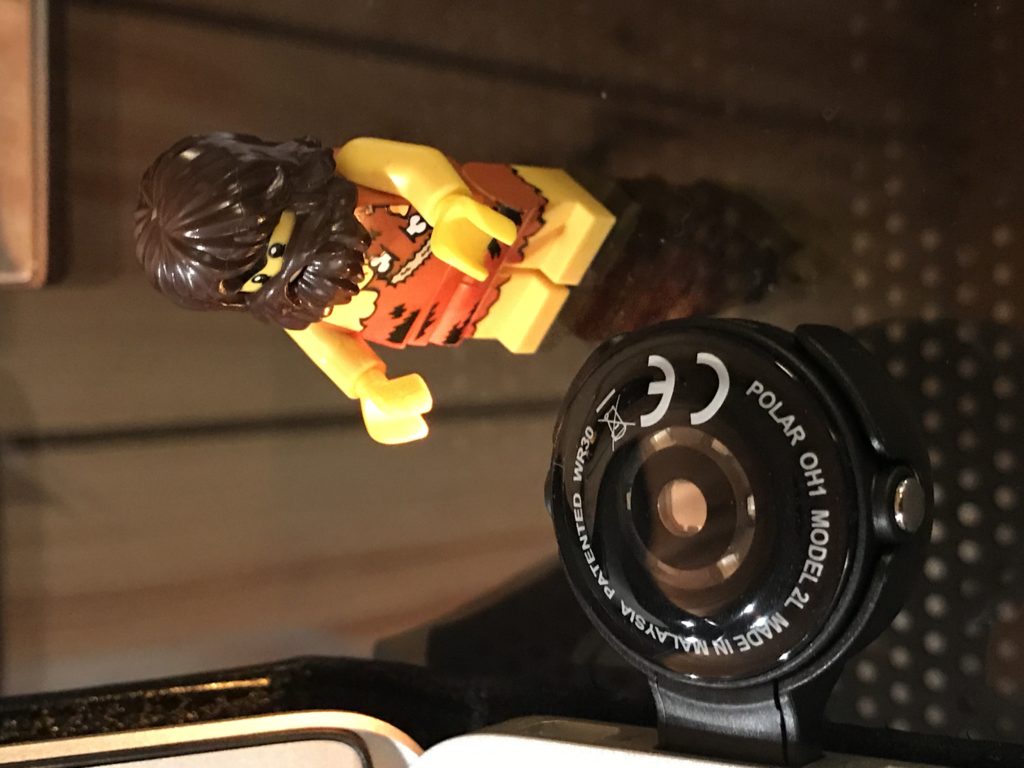
The OH1 while charging.
As mentioned before I used the H7 strap and eventually switched over the great OH1. The battery life of the H7 was amazing and lasted about 3 months before needing to be replaced. Polar sells a small package including the battery plus the rubber seal for water resistance as well, and it is very easy to change the battery. The OH1 however needs to be charged after each sizeable work out. I found this to be a fair trade off due to its convenience and superior performance. Since I had switched to the OH1, Polar had introduced the H10 chest strap system which I never used. It like the OH1 can store data for activities such as hockey for times when wearing your watch or may prove reckless.
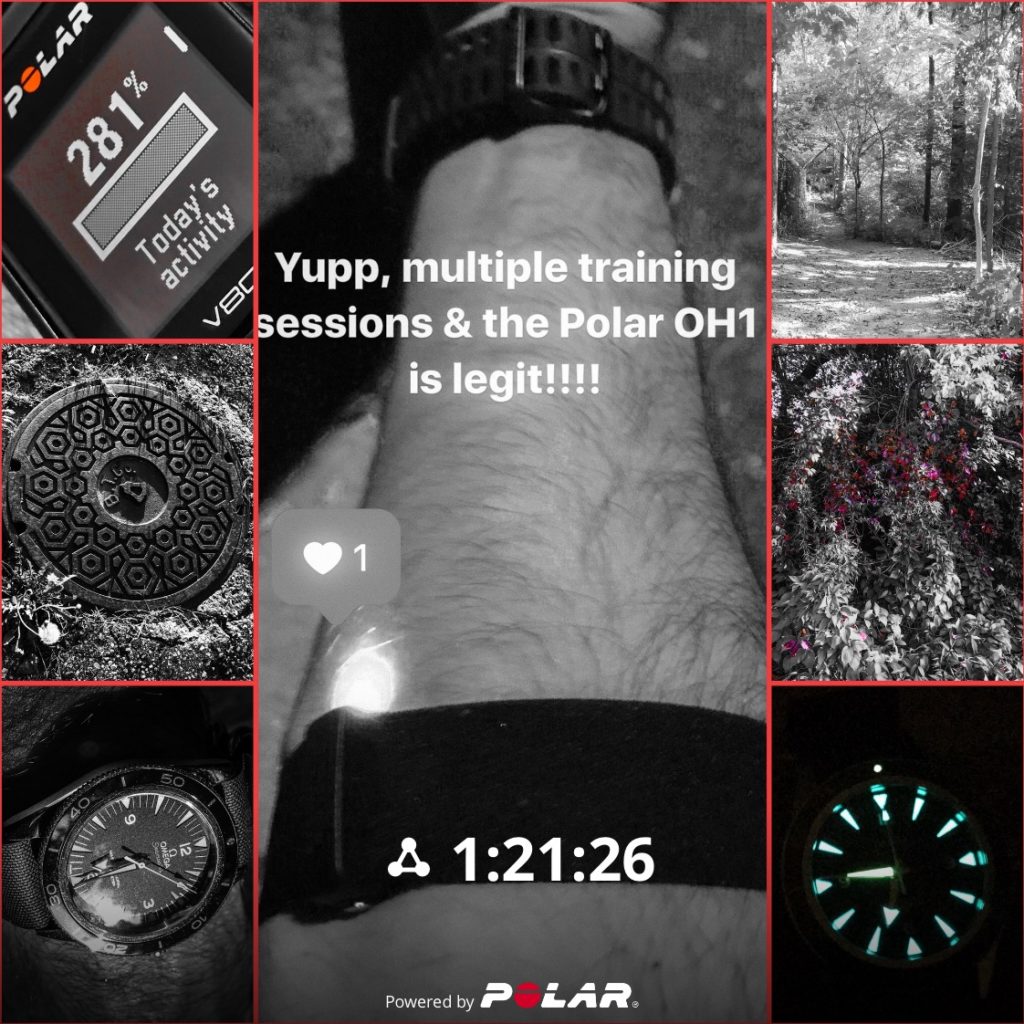
The OH1 in action alongside my other time piece worn while on that run. Also pictured is a manhole which I somehow managed to trip over twice.
Workout Metrics:
Unlike many other devices on the market, due to its original release date being a couple of years ago, the V800 does not have wrist based heart rate monitoring. This is usually not a problem for people who use higher end fitness watches for they usually rely on a chest strap for better measurements. This has mainly changed now due to advancements made in wrist based heart rate monitoring. I at first used the Polar H7 chest strap and though it did the job, it was a pain to use and it did cut out and stop working if my workout involved a lot of movement. Thus when Polar released their amazing OH1 Heart Rate Monitor which is based on the LED technology in their M430, I bought it without hesitation. I did not regret this decision in the slightest for not only did the OH1 perform more consistently, but it was easier to use on occasions where I was meeting friends at a destination in the middle of a run. I found myself having to go into a public restroom on a couple of occasions to remoisten the H7 and put it on before continuing my run and this was not a fun experience.
Side story, on one of these occasions while I was remoistening the strap in a public restroom, a gentleman entered the stall next to the sinks and started crying. Not a little whimper, but a loud wailing which pretty much ruined my entire month. When I asked him if he was ok and if I could help he told me that he was beyond help.
Back to the review.
The only thing which you should be mindful of while using a Polar product is that they rely on your heart rate only to measure your workout intensity. So if you are doing an activity such as Yoga, Pilates, or a low impact strength training session you will be disappointed afterwards by how that impacted your Activity Bar. I adjusted to this over time naturally but at first I was a simply annoyed. You can change the heart rate zones for each Sport Profile (of which there are many, but one for treadmill running was and still is missing) to adjust how it effects the activity bar if you must, but I simply accepted the systems limitations.

An example of the various screens.
What is missing is a Treadmill Sport Profile. To get around this I turned off the GPS for running and let the accelerometer do its best. It became more accurate the faster I would run, but it was generally overestimating my distance by 10%. I would later then have to log into the Polar Flow web based app on the desktop (I could not make the adjustment on the mobile app) and then manually change the distance. This extra step is annoying and not what one wants to be doing in the age of convenience that we are living in. My Garmin for example asks me what the actual distance was after each run on the device, thereby allowing me to quickly make the adjustment and get on with my day.
Side Story: I decided to get a treadmill after nearly being run over for what must have been the fourth time on one run. While running on a major street, a gentleman in his base leased German four-cylinder luxury sedan almost ran me and seven other pedestrians over while making a right turn. Asking for a couple of the pedestrians to stand in front of his car while I confronted the driver, I noticed that he was catching up on Game of Thrones on his phone. While (expletive) driving! I then proceeded to tell him step by step what had happened in the following seasons (he was on season two) to every character and even told him what happened in the books if he ever decided to take up reading. Needless to say, he was in tears, the almost run over pedestrians were laughing, and I bought a treadmill the following afternoon.
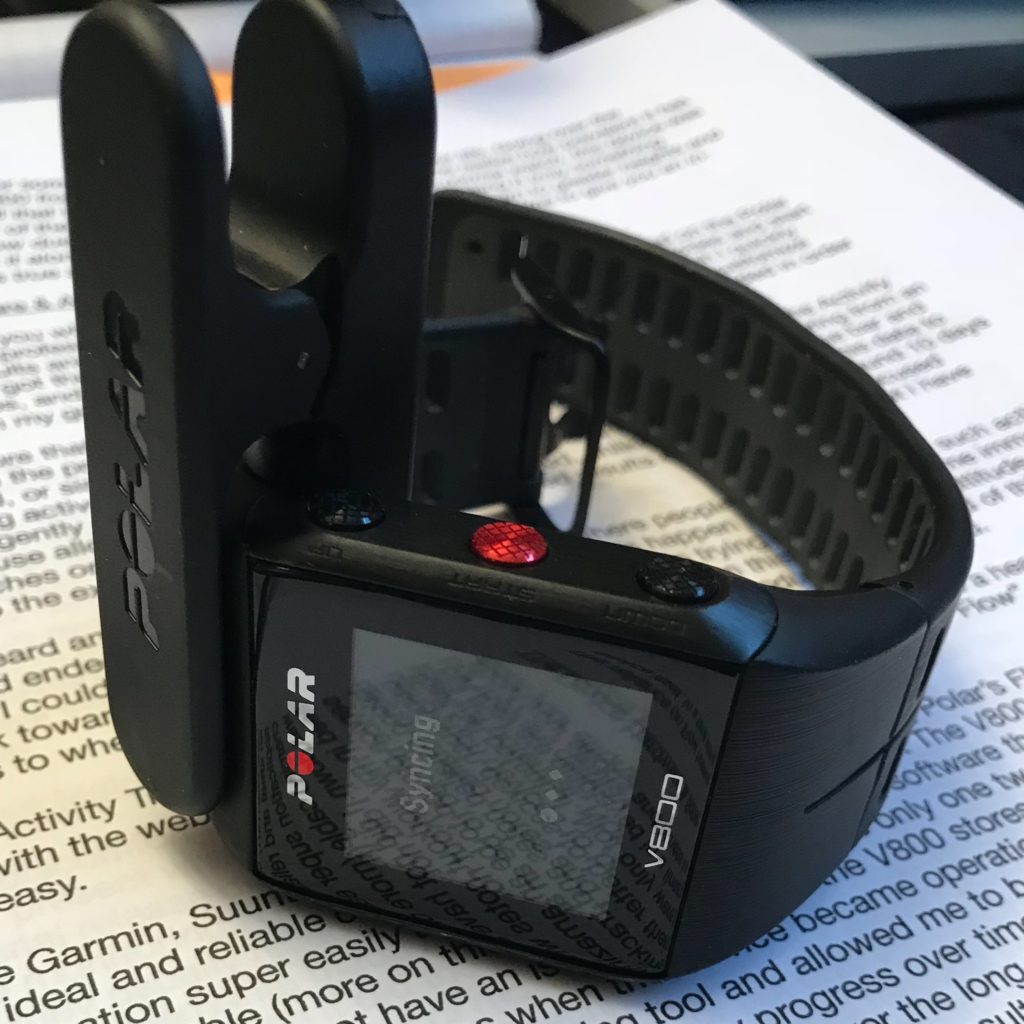
The charging clip.
The fitness tests such as V02 Max like other devices on the market overestimate your performance ceilings. I can tell you with the utmost confidence that I am not an elite athlete no matter how much my V800 thinks this is so. It was gratifying to see such test numbers gradually rise and to see the thresholds and limits of my heart rate improve over the year never the less.
Recommendations:
After an amazing year with the Polar V800 I actually would not recommend it to anyone who is looking to purchase such a device. I would recommend the newly released Polar M430 which nearly has all of its features, plus it has the amazing new wrist based heart rate monitoring system as I experienced with the OH1, all the while costing half as much. I went ahead and switched over to a Garmin Descent Mark 1 recently due to my frequent diving and for its added GPS functionality. Keep in mind though that my Garmin costs about five times the amount of the M430.
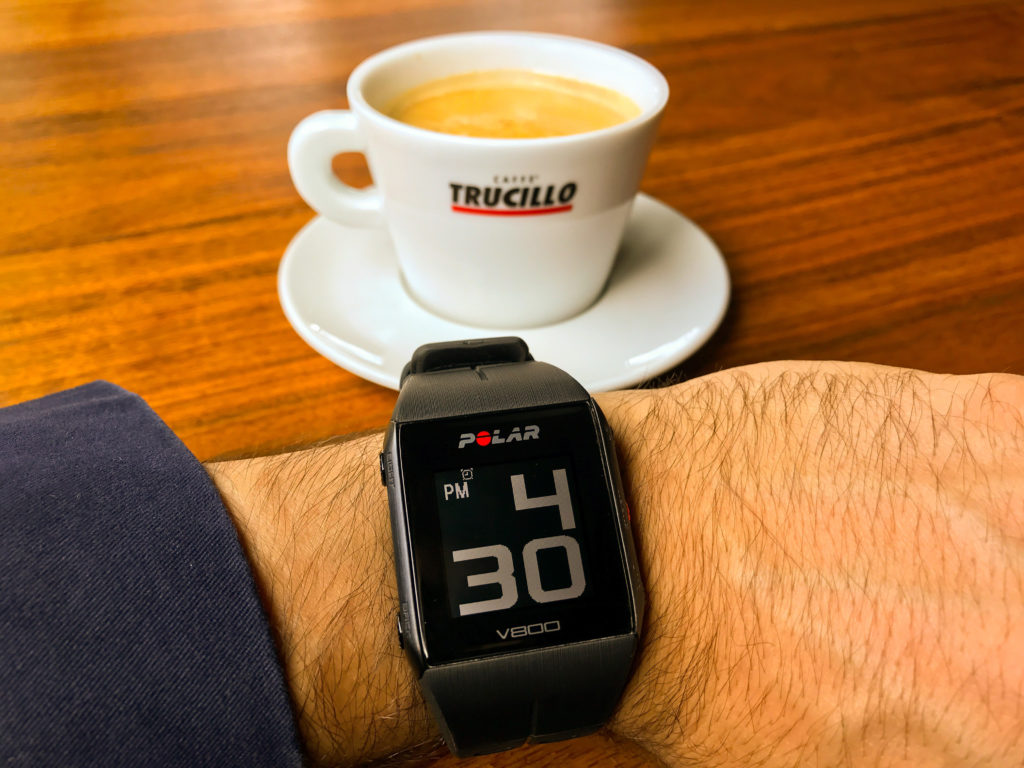
I will miss this device dearly.
If however you are comfortable spending around $650 CAD on such a device, the Garmin Forerunner 935 is a superior device in every manner except build quality. If you want the V800’s level of build quality then spend a little more and get the Garmin Fenix 5, which is almost identical to the Forerunner in terms of software and compatibility with peripheral devices. The Fenix series can become quite expensive depending on which model you choose to get however.
In conclusion I would only recommend this and other serious GPS Sports Watches for those who are dedicated and motivated about their physical training. Those who just want to start might end up wasting a lot of money only later to find their device in a drawer. This is where the M430 is in a sweet price point. Only being marginally more expensive than a fully featured activity band, this device is the one that I would hands down recommend for anyone. Not only is the hardware, operating system, and Flow application essentially bullet proof, but a joy to use. The Garmin Forerunner 935 is the next device which I would recommend for it is very closely designed and related to my Garmin Descent and the Fenix 5 series. Alongside its extra GPS features and software options, Garmin’s Connect IQ application and web service are very intuitive, and actually encourages the user to use their device more often and as a result, live a more active and healthy lifestyle.
Time of writing April 29th 2018
Updated on May 12th 2018